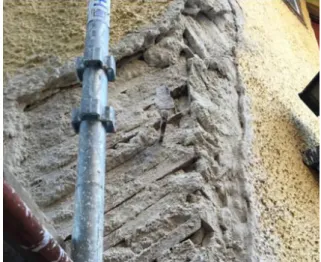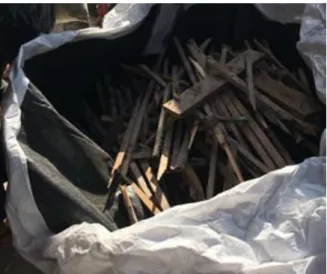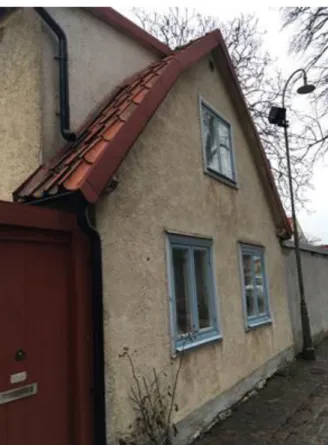EcoGRAFI
2nd International Conference on Bio-based Building Materials & 1st Conference on ECOlogical valorisation of GRAnular and FIbrous materials June 21th - 23th 2017
Clermont-Ferrand, France
SUSTAINABLE INSULATION OF HISTORICAL WOODEN AND STONE
BUILDINGS WITH LIME-HEMP
P.B. Strandberg-de Bruijn1*, K. Balksten2, A. Donarelli2
1 Lund University, Faculty of Engineering, Division of Building Materials, Box 118, SE-221 00
Lund, Sweden
2 Uppsala University, Campus Gotland, Faculty of Art History, Conservation, Cramérgatan 3,
SE-621 57 Visby, Sweden
*Corresponding author; e-mail: paulien.strandberg@byggtek.lth.se
Abstract
In this multidisciplinary project lime-hemp is studied as a thermal insulating material for the renovation of historic timber and brick buildings*). Focus is on buildings in the historic city of Visby on the Swedish island of Gotland in the Baltic sea. Many historic buildings in Visby have over the past decades been thermally insulated with materials such as mineral wools and polystyrene. Due to this, damage caused by moisture and microbial growth has increased. As a consequence, cultural and historical values have been damaged. Lime-hemp is a sustainable building material that consists of hemp shiv and building limes. It works differently than conventional insulating materials; in addition to good thermal insulation properties, it also has good thermal mass and moisture buffering capacity. This project will study the durability of the lime-hemp, especially microbial growth and moisture problems, and opportunities for renovation of historic buildings, while creating a good indoor climate and preserving historical values. Lab-studies as well as full-scale Lab-studies are conducted. The aim of the project is to sustainably improve energy efficiency while preserving historical values, without durability problems.
*) The project started in September 2016 and results are not expected until earliest autumn 2017. The article will therefore give an outline of the project and some preliminary findings.
Keywords:
Renovation, historic buildings, hemp, lime, insulation
1 INTRODUCTION
Improving energy efficiency of buildings has been promoted by the Swedish government from the energy crisis in the 1970’s and onwards. As a consequence, many historic timber and brick buildings in Sweden have been renovated and thermally insulated with modern insulation materials such as mineral wools and polystyrene. Damage caused by moisture and microbial growth problems arose when buildings were thermally insulated. As a result, the Swedish National Heritage Board (RAÄ) released a publication in the beginning of the 1980’s focusing on caution with regards to building physics and preservation of cultural historic values when thermally insulating historical buildings [Riksantikvarieämbetet 1981]. An important question was how to reduce energy consumption and environmental impact of our cultural heritage and historical buildings without diminishing or damaging its cultural and historical values?
Using lime-hemp for insulating historic walls could improve both energy efficiency and moisture conditions in the wall. Our hypothesis is that using lime-hemp would improve the building's energy efficiency without leading to moisture and durability problems.
Lime-hemp consists to a large part of industrial hemp shiv, a renewable resource from agriculture that can be grown locally in Sweden. Today's low demand and a previous ban on cultivating hemp have meant that hemp cultivation still is modest. Since 2014 total hemp cultivation in Sweden has been less than 50 hectare per year. However, hemp grows well in Sweden and the country has a large potential to increase its hemp cultivation. In addition, Sweden (and in particular the island of Gotland) is rich in lime and has both small-scale traditional and large-small-scale industrial lime production. The advantages of building with lime-hemp are amongst others its low environmental impact, good thermal insulation properties, thermal inertia, good acoustic properties and its unique porosity [Amziane and Arnaud 2013]. Add to this that it is sprayable which means that it is easy to handle for the artisan.
Hemp shiv was first introduced in building materials in France in the early 1990s. Hemp shiv was initially used to make concrete mixes lighter [Evrard, De Herde, and Minet 2006]. From there development of the mix showed that hemp shiv is very advantageous to be used in combination with building limes. Several projects in the United Kingdom are known where
lime-hemp is used in renovations of historical buildings [Stanwix and Sparrow 2014].
A thermally insulating material like lime-hemp could mean a new era in the renovation of historic buildings. Lime-hemp has a unique porosity [Arnaud and Gourlay 2012; Collet et al. 2008] and a unique moisture sorption, moisture transport and phase change of water vapour to liquid water [Arnaud and Cerezo 2001; Collet et al. 2008; Evrard and De Herde 2010]. Conventional thermal insulation materials such as mineral wool and polystyrene do not have sufficient thermal inertia or moisture buffering capacity. Lime-hemp has good potential for renovation of historic walls in need of thermal insulation, thermal mass, improved acoustics and moisture buffering capacity. More knowledge is needed, however, including the material's resistance to microbial growth in a cold and rainy Swedish climate. Also practical studies are required to study the possibilities of the material in terms of workability and preserving cultural and historic architectural values.
Practical case studies will be performed on test walls that will be built outdoors at the test facility of the Division for Building Materials and the Division of Energy and Building Design, Lund University.
The project will apply the “Method for status determination of historical buildings” that is being developed by Arfvidsson, Bjelke-Holtermann and Mattsson to determine the status of the historical walls, and will benefit from cooperation and knowledge exchange between projects.
For the Swedish lime industry as well as Swedish agriculture it is a great opportunity to use and manufacture lime-hemp in Sweden. The project is implemented in collaboration with Gotlands Museum, located in the centre of Visby on the island of Gotland. Through case studies in the historic town of Visby the project is embedded in the community and practical applicability can be shown.
1.1 Visby on the island of Gotland
Visby is the largest city on the Swedish island of Gotland, located in the middle of the Baltic sea, approximately 90 km off the coast of mainland Sweden. The city of Visby is an old Hanseatic town and its well-preserved medieval city centre has been on the UNESCO World Heritage Site list since 1995. Most historic buildings in the city centre are built with either a timber structure, limestone blocks or bricks. The most common historic timber technique is the so-called bole house technique (so-called bulhus or
skiftesverk in Swedish). Bole houses were historically
the most common type of building in the countryside of Southern Sweden up until the 19th century [Henriksson 1997]. The bole house construction is most commonly used in the smaller one-family houses in the town center in Visby. Almost 50 % of all buildings in the center are made with this construction technique and the majority of them have rendered facades. Most of them where constructed between 1720 and 1830 [Stadsbyggnadskontoret 2009]. Bole houses are built in timber and characterized by their wall posts with wall planks in between. Often the timber wall planks would be covered with approximately 10 cm of lime plaster embedded between diagonal wooden slats for fixation, and then rendered with a lime-render. The lime was used to give the buildings better thermally insulating properties, and probably also for fire protection. Since the lime render
traditionally has been very thick, renovating with the same technique requires attaching several layers, letting each layer set before attaching the next, which is not considered rational and economically feasible today.
Nowadays building owners often remove the lime plaster and wooden slats on the outside, and replace them with a more modern insulation material such as mineral wool, wood-fibre or polystyrene to improve energy efficiency of the building (Figures 2-4). Then a new cement render or lime-cement render is applied. By using a (lime-)cement render instead of a traditional lime render the historical character of the building is lost, and in combination with the mineral wool or polystyrene insulation its hygrothermal properties are deteriorated.
Figure 1. Exposed plaster embedded in wooden slats on a house in Visby. A lime-cement render had been
applied in an earlier renovation (yellow render).
Figure 2. Exposed lime plaster embedded in diagonal wooden slats on another property in Visby. Here the lime and wooden slats were removed in order to apply mineral wool insulation with the goal to improve energy
efficiency.
The town center in Visby is protected by heritage laws. There is a municipal zoning plan with a building order stating rules for the preservation of the historic town center. A general rule is to remove as little as possible and preserve the existing traditional constructions. Lime-hemp will be studied as a means to preserving the whole wall construction and also to improve its thermal properties; in order to attach lime-hemp it is advantageous to keep the existing construction with wooden slats or pegs. The more we manage to preserve of the traditional construction the less cultural
Figure 3. Wooden slats removed from an historical bole house in Visby (the same property as in Fig. 2).
Figure 4. Exposed timber of an historical bole house in Visby (the same property as in Fig. 2 and 3) after the
wooden slats and lime plaster had been removed.
1.2 Aim of the project
The aim is to find an efficient and economical method for additional insulation of plastered historic wooden and stone buildings that is compatible with the structural materials, that increases energy efficiency and creates a healthy indoor environment, and that preserves and develops the cultural and historical values. The main purpose is to investigate the appropriateness and applicability of insulating with lime-hemp material in historic wooden and stone buildings in a cold Swedish climate with severe moisture conditions. It is imperative that moisture properties of the material are studied in order to secure healthy buildings. The Nordic climate entails a high moisture load on the building, which is why the project's results are imperative to obtain before the material is ready to be used on a larger scale in Sweden. Another target of the project is to evaluate the risk of microbial growth on lime-hemp by building a dynamic model for possible microbial growth on this material. It is very important to examine the risk of microbial growth on lime-hemp, and to develop key performance indicators for its critical moisture levels. Likewise, the project will generate measurable values as a basis for improving energy efficiency of historic buildings that are additionally insulated with lime-hemp.
2 IMPLEMENTATION OF THE PROJECT
The project is carried out at the Faculty of Art History and Conservation, Uppsala University Campus Gotland in Visby and at the Division of Building Materials at Lund Faculty of Engineering, Lund University.
2.1 Microbial growth and durability
Material samples will be tested in the Microbiology lab at the division of Building Materials, Lund Faculty of Engineering. The material will be exposed to varying moisture loads at different time intervals in order to determine its susceptibility to microbial growth and to study the effect of relative humidity and the material’s pH-value on this process. Using isothermal calorimetry, the microbial activity is determined by measuring the metabolic heat that is produced by the sample [Wadsö and Bjurman 1996]. This is an effective and reliable method for studying the level of microbial activity in building materials [Li et al. 2007] and could also be used to measure the activity of microbial growth on lime-hemp samples.
2.2 Full-scale studies/case studies
Implementation and adhesion of the lime-hemp material was studied and tested during lab studies. Different limes and lime:hemp ratios were tested. A wet-slaked lime from Gotland (Byggnadshyttan) showed superior adhesion properties compared to a lime-hemp mix with NHL 3,5 (St Astier). Workability of the wet-slaked lime from Gotland was good, it was easy to apply as a thick render, see Figure 5. Lime-hemp was also applied in between wooden rafters/slats, see Figure 6. The rafters created a good structure for the lime-hemp mix to be applied to. At Lund Faculty of Engineering a lab is available where façade sections can be changed and the energy performance of the room behind the façade can be monitored, see Figure 7.
Two wall sections will be constructed here during the spring of 2017; one wall section consisting of timber with a lime render (representing a traditional historical bole house façade), and a second wall section will have a similar timber construction, but with a thick exterior lime-hemp render. The wall sections will be exposed to actual moisture loads and temperatures that can be monitored over time during 2017-2018.
Figure 5. Testing adhesion and workability of lime-hemp in the lab.
Figure 6. Testing workability of lime-hemp in between wooden slats in the lab.
Figure 7. Two façade sections will be replaced with “historical” timber façades.
Figure 8. Historical timber building in Visby. The façade will be renovated using lime-hemp in 2017.
In the two rooms behind the two wall sections temperature is kept at constant room temperature, and energy use is monitored continuously, resulting in a value for energy performance (in kWh/m²·year). In the late summer of 2017, lime-hemp will be used for additional thermal insulation of an external wall in an historical timber building in Visby, see Figure 8. Sensors to monitor relative humidity and temperature over time will be placed in the walls. Workability and compatibility with the historical structure will be studied.
3 DISSEMINATION OF RESULTS
An outline of the research project was presented at the Nordic Lime Forum meeting in Malmö, Sweden, in the autumn of 2016. In February 2017 an information meeting was organized in Visby together with Gotlands museum. Here the project was presented to professionals working in Visby. These were artisans, builders, architects as well as representatives for the Municipality and the Region of Gotland. The material and application methods can be disseminated in an open dialogue with professionals who work with historical buildings, so that knowledge can be shared with more people who have a clear connection to the end-user. An important goal in the project is to communicate continuously with the public and professionals in order to create a dialogue between our research project and potential users of lime-hemp as a building material in historical buildings in Sweden. The project started in September 2016 and will continue until December 2018.
4 ACKNOWLEDGMENTS
This research project is conducted with financial support from the Swedish Energy Agency and the Alrik Örborns Foundation. Their financial support is gratefully acknowledged. The authors would like to acknowledge Byggnadshyttan Kalk & Bygg AB, Nordkalk and Målarkalk AB for contributing with lime and Hampaprodukter AB for contributing with hemp shiv in the project.
5 REFERENCES
Amziane, S.; and Arnaud, L. eds. 2013.
Bio-Aggregate-Based Building Materials. ISTE Ltd and
John Wiley & Sons, Inc.
Arnaud, L.; Cerezo, V. 2001. Qualification Physique
Des Matériaux de Construction À Base de Chanvre.
Vaulx-en-Velin.
Arnaud, L.; Gourlay, E. 2012. Experimental Study of
Parameters Influencing Mechanical Properties of Hemp Concretes. Construction and Building Materials
28(1):50–56.
Collet, F.; Bart, M.; Serres, L.; Miriel, J. 2008. Porous
Structure and Water Vapour Sorption of Hemp-Based
Materials. Construction and Building Materials
22(6):1271–80.
Evrard, A.; De Herde, A. 2010. Hygrothermal
Performance of Lime-Hemp Wall Assemblies. Journal
of Building Physics 34(1):5–25.
Evrard, A.; De Herde, A.; Minet, J. 2006. Dynamical
Interactions between Heat and Mass Flows in Lime-Hemp Concrete. Research in Building Physics and
Henriksson, G. 1997. Swedish Bole Houses - From
Medieval Times to the Present. Stockholm: The
Swedish Council for Building Research.
Li, Y.; Wadsö, L.; Larsson, L.; Bjurman, J. 2007.
Correlating Two Methods of Quantifying Fungal Activity: Heat Production by Isothermal Calorimetry and Ergosterol Amount by Gas Chromatography-Tandem Mass Spectrometry. Thermochimica Acta
458(1–2):77–83.
Riksantikvarieämbetet. 1981. Spara Och Bevara : Råd
Och Riktlinjer För Energisparande i Kulturhistoriskt
Värdefull Bebyggelse. Stockholm: Statens råd för
byggnadsforskning.
Stadsbyggnadskontoret, Gotlands Museum. 2009.
Byggnadsordning För Visby Innerstad. Visby, Gotland:
Gotland kommun.
Stanwix, W.; Sparrow, A. 2014. The Hempcrete Book
Designing and Building with Hemp-Lime. Cambridge,
United Kingdom: Green Books.
Wadsö, L.; and Bjurman, J. 1996. Microcalorimetry as
a Tool for Studies of Fungal Degradation of Wood. Trä


